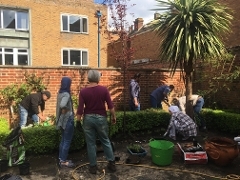Herbs, flowers, lotions and potions
Syrian refugees are bringing us closer to medicines, perfumes and cosmetics once made at Guildford House.

This summer we've been working with a number of Syrian refugee families to redevelop part of the courtyard garden at Guildford House. They have taken inspiration from the history of Guildford House, which was built in 1660.
We've been working with colleagues in arts development, community wellbeing and family support, as well as a professional artist and gardener. We first worked with the participants during autumn 2018 on a project that compared the scenery and built environment in Guildford with that of Syria. Many of the participants had an interest in gardening and as one of the flower beds at Guildford House was looking a bit tired, this seemed like an opportunity for a project not to be missed!


We began learning a bit about Guildford House and about gardening in the 17th century when the house was built. The garden had many functions - it contained the Brewhouse (still in existence today) which was the building used to brew beer, bake bread and do the laundry. There were also stables for horses and a brick summerhouse - the columns and cornice for this are now attached to the back of the Brewhouse.

In addition, there was a garden on the other side of North Street, which was just a ditch at the time. The garden was an important place to grow fruit, vegetables and herbs. These provided food to eat but the herbs were also used in medicines, at a time when there were not that many doctors around!
We think the owner's wife, Olive Childe, may have had a 'still room' at the bottom of the house near the kitchen (today's café) where she made up medicines, perfumes and cosmetics.

Those taking part in the project wanted their flower bed to be both beautiful and useful. It therefore contains a mix of flowers, fruits and herbs, which were cultivated in the 17th century. They have planted a cherry tree and an apple tree trained as an espalier (branches grow flat against a wall).
Did you know that this style of growing was popular in the 17th century? The herbs planted during the project include Bay and Fennel. According to Culpeper both of these were good for expelling wind and "provoking urine"!
They have also planted the lesser known herb, Lovage, believed to cure a range of illnesses from sore throats to rheumatism. The name also gives another clue to this herb's use; some people thought it was an aphrodisiac.
Other herbs in the flower bed include Thyme, Borage and Rosemary. Culpeper said Thyme made into an ointment was good for getting rid of warts. Borage was traditionally used to treat 'melancholy' (depression). People thought taking Rosemary led to improved memory, a better immune system and strong hair growth. Culpeper said smoking the dried leaves in a pipe was good for coughs!
The participants have also planted two roses of the variety called , as a nod to the famous garden designer who spent much of her childhood living just outside Guildford. The Syrian families have also been working on a second garden at the Park Barn Social Centre. They have worked with the users of the centre, which offers activities for over 55s.
The project participants have been lucky enough to work on their designs and planting with artist Mary Branson, who has one of her pieces of work in the Houses of Parliament, and professional gardener Jo Carter who has worked on gardens at Chelsea Flower Show.
People taking part in the project had a variety of reasons for getting involved. Many were interested in gardening and had tended their own gardens back home in Syria. They wanted:
"to know more about...British gardens"
"to know more about the history in Guildford"
"To thank Guildford [for] welcome us"
The participants have attended English language classes and the sessions have provided a chance for them to practise their English informally, working alongside staff. Several participants said they also "love working together". They live across the borough of Guildford so the project has been an opportunity for them to come together. Guildford House Gallery has benefited from a reinvigorated flower bed, which we hope will achieve one of the participant's wishes "to see the happy look on people's faces".
And in case you didn't know, the courtyard garden at Guildford House has a great Gallery Café, so pop along this summer to take in one of our exhibitions, visit the café and of course have a look at the new flower bed.
There is also our free Family Fun Morning Saturday taking place on 17 August. We will be taking you back in time to Olive Childe and her secret remedies made here at the house in the 17th century. We'll also be making herb-filled bath sachets and room fresheners. Find out more on our
Blog post by Melanie Holliker, Access Officer.
